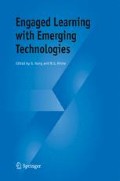Abstract
In this Knowledge Age or innovation-driven age, knowledge is a key asset for a society to create value. The health and wealth of societies depend increasingly on the capacity of people to innovate (Scardamalia & Bereiter, in press 2002). Since schools are responsible for preparing the young for the future they have to be models of innovation, where teachers and students are “willing to take new routes, try different methods, and occasionally break the mould” (Shanmugaratnam, 2003). Too often, however, we find classroom pedagogies varying between two extremes: didactic knowledge transmission where teachers are the “sage on the stage”, or constructivist approaches where students are actively engaged on activities. The former approach is often criticized for treating students as a passive party, assuming that knowledge can be transmitted and assimilated into the student’s mind. The latter approach, on the other hand, has the tendency to motivate students to complete tasks and activities, but not necessarily engaged with the knowledge creation process. In this chapter, we argue that we should engage our students directly in knowledge production, not so much of asking students to produce new knowledge or discoveries, but putting them into a development trajectory to be knowledge producers. Examples of knowledge building classrooms in Cananda and Singapore schools will be used to illustrate how we can engage students as knowledge producers, who take on ownership of learning by collaboratively and continually improve upon their initial ideas to better ideas, thus advancing collective knowledge within the community.
Access this chapter
Tax calculation will be finalised at checkout
Purchases are for personal use only
Preview
Unable to display preview. Download preview PDF.
References
Bereiter, C., & Scardamalia, M. (1996). Rethinking learning. In D.R. Olson, & N. Torrance (Eds.), The handbook of education and human development: New models of learning, teaching and schooling (pp. 485–513). Cambridge, MA: Basil Blackwell.
Casewell, B., Lamon, M. (1998). Development of scientific literacy: The evolution of ideas in a Grade Four knowledge-building classroom. Paper presented at the Annual Meeting of the American Educational Research Association, San Diego, CA, April 13–17.
Drucker, P. (1985). Innovation and entrepreneurship: Practice and principles. New York: Harper and Row
Duffy, T. & Jonassen, D. (Eds.) (1992). Constructivism: New implications for instructional technology. In T.M. Duffy & D.H. Jonassen (Eds.), Constructivism and the technology of instruction: A conversation (pp. 1–16). Hillsdale, NJ: Lawrence Erlbaum Associates.
Hakkarainen, K. (2003). Emergence of progressive-inquiry culture in Computer-Supported Collaborative Learning. Learning Environments Research, 6(2),199–220.
Hewitt, J. (2001). From a focus on tasks to a focus on understanding: The cultural transformation of a Toronto classroom. In Koschmann, T., Hall, R., & Miyake, N. (Eds.), CSCL 2 carrying forward the conversation: Computers, cognition, and work (pp.11–41). Mahwah, NJ: Lawrence Erlbaum Associates.
Jones, B., Valdez, G., Nowakowski, J., & Rasmussen, C. (1994). Designing Learning and Technology for Educational Reform. Oak Brook, IL: North Central Regional Educational Laboratory.
Lamon, M., Reeve, R. & Scardamalia, M. (2001, April). Mapping the growth of deeply principled understandings in a knowledge building community. Annual Meeting of the American Educational Research Association. Seattle, WA. Retrieved 22 March 2004 from http://ikit.org/lamon/mapping.html
Meehan, S., & Nolan, M. (2001). Handbook of engaged learning projects. Retrieved on 21 March 2004 from http://www-ed.fnal.gov/help/cover.html
Perkins, D.N. (1991). Technology meets constructivism: Do they make a marriage? Educational Technology, 31(5), 18–23.
Scardamalia, M. (1999). Moving Ideas to the Center. In L. Harasim (Ed.), Wisdom & Wizardry: Celebrating the Pioneers of Online Education (pp. 14–15). Vancouver, BC: Telelearning, Inc.
Scardamalia, M. (2004). CSILE/Knowledge Forum®. In Educational technology: An encyclopedia. Santa Barbara: ABC-CLIO.
Scardamalia, M. (2003). Knowledge building environments: Extending the limits of the possible in education and knowledge work. In Encyclopedia of distributed learning. Thousand Oaks, CA: Sage Publications.
Scardamalia, M., & Bereiter, C. (2002). Knowledge building. In Encyclopedia of education (2nd Ed.). New York: Macmillan Reference, USA.
Shanmugaratnam, T. (2003). Speech at the MOE Work Plan Seminar at Ngee Ann Polytechnic on Thursday, 2 October 2003. Retrieved 31 March, 2004, from http://www.moe.gov.sg/speeches/2003/sp20031002.htm
Trilling, B., & Hood, P. (1999). Learning, technology, and education reform in the Knowledge Age or “We’re Wired, Webbed, and Windowed, Now What?” Educational Technology, 39(3), 5–18.
U.S. Department of Labor, Secretary’s Commission on Achieving Necessary Skills (SCANS). (1992). Learning a Living: a Blueprint for High Performance. Washington, DC: U.S. Department of Labor
Author information
Authors and Affiliations
Editor information
Editors and Affiliations
Rights and permissions
Copyright information
© 2006 Springer
About this chapter
Cite this chapter
Tan, S.C., Hung, D., Scardamalia, M. (2006). Education in the Knowledge Age — Engaging Learners Through Knowledge Building. In: Hung, D., Khine, M.S. (eds) Engaged Learning with Emerging Technologies. Springer, Dordrecht. https://doi.org/10.1007/1-4020-3669-8_5
Download citation
DOI: https://doi.org/10.1007/1-4020-3669-8_5
Publisher Name: Springer, Dordrecht
Print ISBN: 978-1-4020-3668-2
Online ISBN: 978-1-4020-3669-9
eBook Packages: Humanities, Social Sciences and LawEducation (R0)

